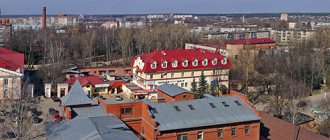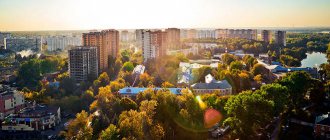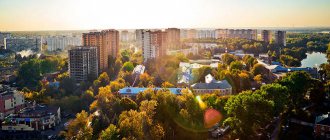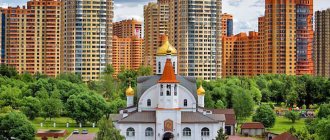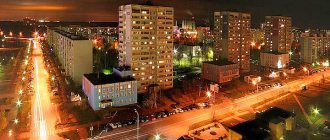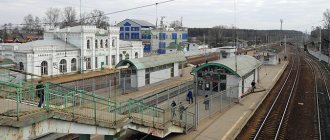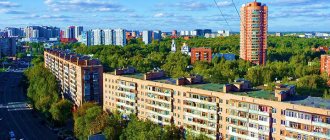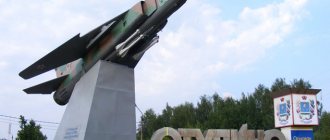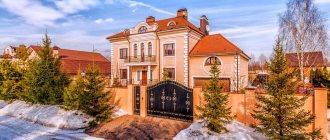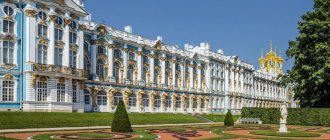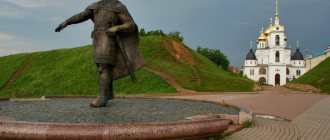The city of Dmitrov is located 65 kilometers from ]Moscow[/anchor], and 50 kilometers from the Moscow Ring Road, north of the capital. It stands on the Yakhroma River and the Canal named after. Moscow. One of the most comfortable cities in Russia. City of Military Glory. Included in the Golden Ring of Russia tourist route. In this article we will get acquainted with the city and its attractions.
Dmitrov history.
Let's start our acquaintance with a little historical background. The city was founded in 1154 by Prince Yuri Dolgoruky in the swampy valley of the Yakhroma River. Named in honor of Vsevolod the Big Nest (baptized Dmitry, son of Yuri Dolgoruky), born that year. The city was conceived as an outpost for the defense of the Vladimir-Suzdal land. Dmitrov was located at the junction of the borders of the Moscow, Tver and Pereslavl principalities. In 1180, during the war between Svyatoslav Vsevolodovich and Vsevolod the Big Nest, Dmitrov was burned. It soon recovered from the ruin and by 1214 it was already a large city with suburbs, and belonged to Yaroslav Vsevolodovich. The city was not spared by the Tatar-Mongols, who burned it about six times.
Metropolitan ambitions and pristine beauty
Dmitrov is a beautiful place where ancient monuments and buildings of different architectural styles live in harmony with nature. The unique relief of the Klinsko-Dmitrovskaya ridge created unique landscapes, the splendor of which will remain in memory for a long time. It is here that the legendary Moscow Canal passes, connecting the Volga and the Moscow River and supplying water and electricity to the capital. Dmitrov is ready to tell his guests the history of the ancient Kremlin, show the origins of Russian anarchy and the life of the people of the Iron Age.
In the very heart of the city is the ancient Kremlin, founded in the 12th century and preserved to this day as a monument of medieval defensive architecture. The earthen rampart, about 1 km long and with an average height of about 10 m, is an interesting historical object. During a walk along it, amazing views of the city open up. You can enter the Kremlin from three sides: from the main city Soviet Square, Torgovaya Square and from Kropotkinskaya Street, one of the most beautiful in the city. The Kremlin houses the magnificent Assumption Cathedral. Next to the Kremlin is the house-museum of Peter Kropotkin.
A ten-minute drive from Dmitrov, on one of the highest points of the Dmitrov urban district, there is a grandiose bronze monument - a 27-meter tall figure of a Soviet soldier. Here, from November 27 to December 5, 1941, bloody battles with the Nazis took place. The observation deck offers a magnificent view of the surrounding area.
The Dmitrovsky urban district is ideal for lovers of active recreation: golf and horse polo, paragliding, helicopters and hot air balloons, cycling and fast enduro cross-country, alpine skiing and curling.
How to get there: by train from Savyolovsky station, by bus No. 401 from Altufyevo metro station, by car along Dmitrovskoye Shosse (road A-104).
The cozy and surprisingly picturesque city of Dmitrov is one of the oldest cities in the Moscow region, carefully preserving its rich history. It was founded in 1154 by Yuri Dolgoruky. It was named in honor of the patron saint of the son of Yuri Dolgoruky Vsevolod the Big Nest - the Great Martyr Demetrius of Thessalonica.
Advantageously located on the western border of the Rostov-Suzdal principality, on the banks of the Yakhroma River, Dmitrov remained an important defensive and trade center for a long time, both during the period of political fragmentation and during the Mongol-Tatar raids. Despite the fact that from the end of the 12th to the beginning of the 15th century Dmitrov went bankrupt six times, it recovered quite quickly. This is confirmed by archaeological studies of the territory of the Dmitrov Kremlin, during which no periods of long-term desolation were identified. At the same time, Dmitrov finds himself at the center of not only military, but also peacekeeping processes. The coat of arms of Dmitrov, approved in 1781, which depicts four princely crowns in an ermine field, preserves the memory of the peaceful congress of four princes that took place in Dmitrov in 1301.
Medieval Dmitrov reached its greatest prosperity in the 15th - early 16th centuries, when it became the most important point on the trade route from the south to the north of Rus'. During the Time of Troubles at the beginning of the 17th century, Dmitrov was devastated by Polish-Lithuanian troops, after which the wooden fortress was never restored.
In the 18th century, Dmitrov became a large trading city with merchants of the first guild, at whose expense numerous parish churches were built. And besides trade, the city and its surroundings were famous for their apple trees, onions, garlic and unique printed gingerbread. By the end of the 19th century, Dmitrov was a small, cozy provincial town immersed in greenery, the center of the vast Dmitrov district.
In Soviet times, in 1932-1937, Dmitrov became the “capital” of the construction of a strategically important facility - the Moscow-Volga canal. In 1941, on the approaches to the city, Nazi troops were stopped and turned back. The battles for Dmitrov and Peremilovskaya Heights became turning points during the entire Moscow operation.
Now Dmitrov is an attractive place for relaxation and exploring historical sights for both Russians and foreign tourists. The historical part of the city, the central square and adjacent streets are a landscaped pedestrian area; there are the “Eternal Flame” Memorial, monuments to Cyril and Methodius, the Hieromartyr Seraphim Zvezdinsky, Yuri Dolgoruky, Peter Alekseevich Kropotkin, Saints Peter and Fevronya of Murom, a multi-figure sculptural composition “Citizens” ", "Stone of Happiness" on the shore of a historical pond and much more. Here, in historical and new buildings, exhibitions of the Dmitrov Kremlin Museum-Reserve, recognized as the best municipal museum in Russia, are located.
Tourist map of the city of Dmitrov and Dmitrov urban district:
Dmitrov history.
Dmitrov, during the period of fragmentation of Rus', passed from one prince to another. In 1569, Prince Vladimir Andreevich of Dmitrov was executed, becoming the last appanage prince in Rus', and the city was transferred to the oprichnina. The period from the 16th to the second half of the 17th centuries. Historians associate it with the decline of the city. The situation changed in 1781, when Dmitrov became the center of the county and, among many Russian cities, received a coat of arms. By the end of the 18th century, a new revival in local trade began, which affected the development of Dmitrov. Stone construction was resumed, old wooden churches were rebuilt, and in 1784 the city received a regular development plan.
Dmitrov history.
In the second half of the 19th century, after the construction of the Nikolaevskaya railway Moscow - St. Petersburg through Klin (1851) and the Yaroslavl railway through Sergiev Posad (1869), Dmitrov, while remaining an administrative center, found itself in a relatively disadvantageous economic position. At the beginning of the 20th century, Dmitrov experienced all the hardships of the revolutionary movement. During the period of Soviet power, the construction of the canal to them became key in the history of the city. Moscow. Construction contributed to population growth and industrial development. In the 1960s–1980s, the city was built up with apartment buildings during the period of rapid development of industrial enterprises and acquired the main features of its modern appearance. For the 850th anniversary of the city (2004), a large-scale campaign was carried out to improve and develop the city.
Where to eat in Dmitrov
Any traveler needs not only interesting sights, but also cafes where you can eat normally and not get poisoned. Below are the top 10 Dmitrov cafes according to the Tripadvisor rating (data for 2022):
- Grill Bar Behemoth and Mouse. Address: st. Professional, 4.
- Khinkalnaya Old Dukan. Address: st. Moskovskaya, 3.
- Coffee house "Coffee Time". Address: st. Kropotkinskaya, 59.
- Restaurant Cruise Club. Address: Zheleznodorozhny lane, 3.
- The Cherry Orchard. Address: st. Kropotkinskaya, 75A.
- Yakitoria. Address: st. Sovetskaya, 5.
- About Burger. Address: st. Sovetskaya, 14 Cinema Planeta.
- Dolce Vita. Address: st. Professional, 7.
- Cafe Provence. Address: microdistrict them. A. Markova, 2A.
- Cowberry. Address: st. Sovetskaya, 14.
And, of course, the lifesaver of all travelers is McDonald’s. Address: Professionalnaya st., 3A
Dmitrov today.
In 2005, Dmitrov took first place in the All-Russian competition “The most comfortable city in Russia” in the category “Up to 100 thousand inhabitants”. On October 30, 2008, Dmitrov was awarded the honorary title of the Russian Federation “City of Military Glory.” Over the course of more than eight centuries of history, the city has experienced prosperity and decline, wars, revolutions, and despite this, the city has preserved a large number of architectural monuments.
Dmitrov today
One of the most ancient cities in the Moscow region has a thousand-year history, imprinted in architectural monuments. The domes of nine ancient churches dominate the historical center of the city, overshadowing all residents with their holiness.
The main shrines of the city: the Dmitrov Kremlin and the Boris and Gleb Monastery are well known not only in the Moscow region, but also everywhere where Russians live. Hoary antiquity is revered and lovingly preserved, but this is history, and modernity is presented closer to the outskirts, where new houses are being built day by day. The modern architecture of Dmitrov is no less interesting and multifaceted.
Just like in other areas of the Moscow region, the housing construction boom in the city occurred at the beginning of the new millennium. During this time, dozens of projects have been implemented that have allowed the majority of citizens to significantly improve their quality of life.
Dmitrov Kremlin.
In the very center of the city is the Dmitrov Kremlin, it is surrounded by an earthen rampart that has survived to this day. The architectural dominant of the Kremlin is the Assumption Cathedral, built between 1509 and 1533. Nearby is an administrative complex (offices, service wings, prison), the buildings of which were built at different times from 1810 to 1830. Much later, a prison Elizabethan church in pseudo-Russian style was added to it. Also within the boundaries of the fortifications there is a gymnasium, a noble assembly and a parochial school. Near the passage of the Nikolsky Gate in 1868, at the expense of the townspeople, in commemoration of the miraculous salvation of Alexander II from the assassination attempt on him in 1866, the chapel of St. Alexander Nevsky in the eclectic “Ton” style.
Monuments to Dmitrov.
Several 19th-century buildings are located southwest of the Kremlin. Among them, the Sukhodayev Hotel (1872) stands out, where the district administration is now located. Behind it, along Sovetskaya Street, is the former Spasskaya Church, rebuilt in Soviet times and now occupied by the services of the Dmitrovsky district administration. There are a large number of monuments in the city. The monument to Yuri Dolgoruky, Boris and Gleb, Cyril and Methodius are the most interesting of them. On the territory of the city there is the Architectural complex of the Boris and Gleb Monastery.
The city of Dmitrov certainly deserves the attention of tourists; all the necessary infrastructure has been created for this. Dmitrov is perfect for a weekend tour. In a couple of days you can explore the main attractions, visit several museums and enjoy the peace and tranquility of the provincial town. We tried to tell you the most interesting things about the beautiful city of Dmitrov, we wish you great travels and positive emotions.
Sports and life after sports in Dmitrov
At one time, the city of Dmitrov was an ordinary town in the north of the Moscow region. No one was particularly interested. But at the very beginning of the 21st century, the Russian government became interested in alpine skiing and decided to organize the Alps at its side. I think that because of the acceptable mountain landscape, the choice fell on the Dmitrovsky district, especially since there were already some developments in skiing.
In the village of Yakhroma, near Dmitrov, a ski resort was organized. And things went well. Many bigwigs began to rest physically and mentally there. Restaurants, hotels, banquet halls, clubs, SPA centers and, of course, high-quality trails were built and equipped with the latest technology. The city and region lived happily ever after. I know for sure that during the crisis, when the district was unable to pay for electricity, its debt was written off in whole or in part. What can you not do because of your love for skiing and a healthy lifestyle!
During this time, sports facilities were opened not only in Yakhroma. In Dmitrov itself, a huge full-service fitness center and several ice palaces for various sports were built.
One of the ice palaces. Photo by https://fotki.yandex.ru/users/polk51890/
And all this was followed by the opening of numerous sportswear stores. In a city with a population of 60,000 people, there are more than fifteen sports equipment and ammunition stores! Now they are slowly starting to repurpose themselves into grocery departments.
And then the rulers’ love for Dmitrov and for sports near Moscow faded a little. The district is no longer so generously funded. And many large objects have already been set up! It seems like it's good, but it's not all that beautiful. In order to adequately maintain buildings, complexes, roads and other infrastructure, a constant influx of funds is needed. The district ran out of money. Many private owners closed shops and factories and began renting out premises. Only one plant remained operational in the city. With Yakhroma everything is not so sad. Dmitrov residents and Muscovites still go there on weekends to barbecue and ski.
I'm a young girl. I love shopping, but in Dmitrov, apart from sportswear, there are practically no normal clothing stores. There is one large shopping center in the city, but you can walk around it in 10 minutes and not find anything interesting. There are several brand stores with medium and low prices for outfits, but they do not bring new collections. Everyone goes to Moscow to buy clothes. And at work too!
Shopping arcades in the city. Photo by jul-karina (https://fotki.yandex.ru/users/jul-karina/)
Electric trains run every hour to Savyolovsky station. But you can get to the capital by car without traffic jams only at night or early in the morning. The road to Dmitrov has been undergoing major repairs for several years now. It is not being expanded, but additional interchanges and overpasses are being made. If you need to get to Moscow during the day, then the average speed will be no more than 12 km/h. But we have to go! Without visiting the capital's shopping centers, including grocery stores, it is difficult to live in a small town with low salaries. It is considered good if you receive 20,000 rubles.
In general, many of my friends began to buy goods in online stores. They order delivery to Savelovsky Station, go there by train and pick up what they bought. Online stores do not like to deliver purchases to Dmitrov. The road is crooked, with traffic jams and populated areas. If they take delivery, the price will be so high that you will think 10 times about the need for such a service.
Historical square. Photo by jul-karina (https://fotki.yandex.ru/users/jul-karina/)
For entertainment, there are cinemas, one theater, a historical landmark, 3 clubs, several cafes and restaurants. In good weather, everyone walks around the center and in the grove. In summer there is nowhere to swim, unless you find some small pond. The Moscow Canal runs near the city, but it is not suitable for swimming.
A lot of people go to work at Sheremetyevo Airport or Moscow. Some people take their children to study in Moscow schools, gymnasiums or lyceums. In Dmitrov itself there is a real problem with higher educational institutions. You can get a higher education in just one institution. Again, young people leave for the capital and then don’t come back. There are simply no young teachers and doctors in the city. On the one hand, it’s good that mostly experienced specialists treat and teach. What to do when they all retire? Of course, they will find someone to take the place of teachers and doctors, but who it will be is unclear. Young people are eager to go to Moscow! The city of Dmitrov is turning into a kind of village where parents live and are waiting for their children for the weekend. And parents with small children who, already in high school, begin to study in Moscow schools.
And Muscovites began to move here. A village of town houses was built in the city. Residents of the capital very quickly bought up the houses there. In general, there are no huge problems with housing in the city. Several new buildings have been launched. It's nice that the historical center is not being touched. The city is growing in width due to the annexation of the outskirts and nearby settlements.
New buildings are in the background. Photo by jul-karina (https://fotki.yandex.ru/users/jul-karina/)
Housing is housing, but there are difficulties with transport. I can’t imagine how to live in Dmitrov without a car. There are few minibuses, buses run on such a tricky schedule that not everyone can understand it. There are taxi drivers. Several times, when calling a taxi, I personally heard a negative answer to the question of whether it was possible to call a car. Sometimes you have to wait in line for up to 2 hours. And this is not on holidays! In short, buy a car and you will be happy. It’s just better to take it with a good suspension. After all, Dmitrov is Russia, and the roads here are Russian...
Traffic jams are insignificant compared to the capital's congestion. Usually, they are only in two places. They even make me smile. It's nice that people in Dmitrov started driving around in cars. It’s okay to live in the city if the salary is good. Traveling to work in Moscow and spending the night in Dmitrov is very exhausting and unsettling. Many people give up and calm down after 2-3 years of such a race. After such an experience, someone is trying to open something in the city. As an example, I can cite the fact that there are so many small hairdressing salons in Dmitrov that only Paris has more of them. The level of service there leaves much to be desired, but the prices for services compensate for the inconvenience.
The city itself is not particularly beautiful. There are many Soviet buildings, the roads are narrow and full of potholes. True, it’s easier to breathe than in the capital. There are fewer people and there are no factories left. That is how we live. We secretly dream of Moscow, but at the same time we remain provincial.
